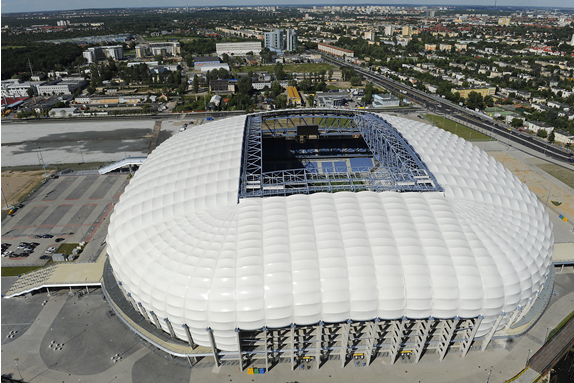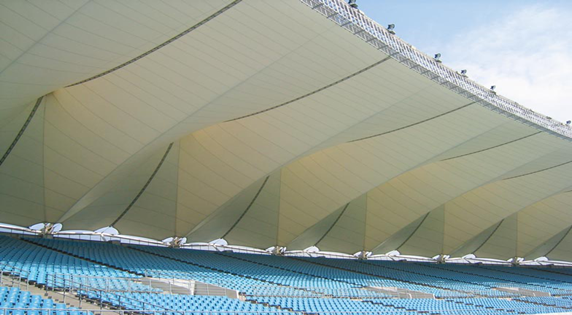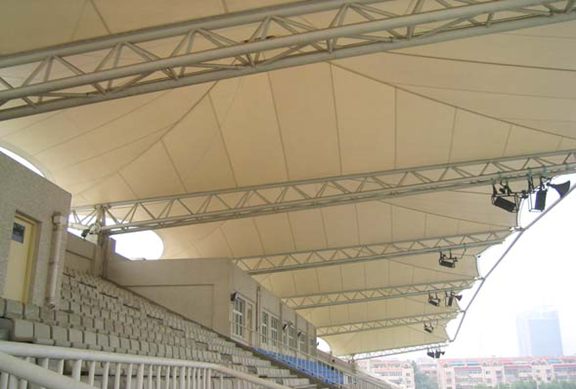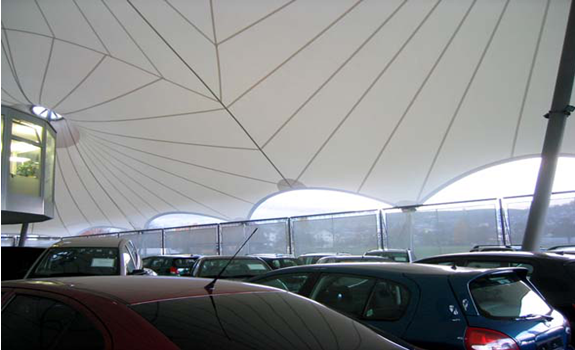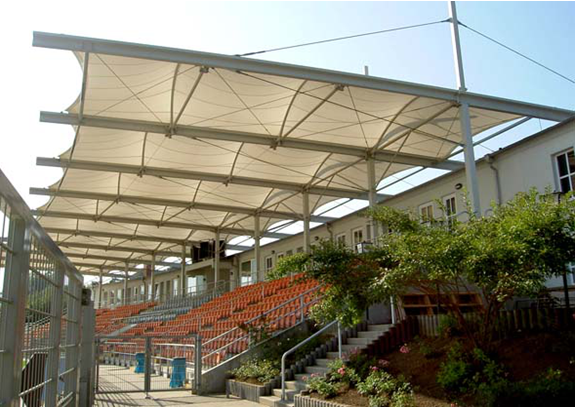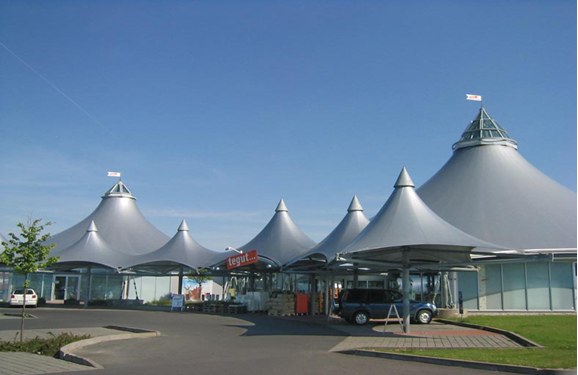Introduction of membrane materials
Service Hotline:13818464305
Business line:021-59198545
400 Phone:400-176-6885
PVDF membrane material
Material properties
Membrane material used in membrane structure building is a kind of membrane material with strength and flexibility. It is woven into fabric base material by fibers. It is processed and fixed with resin as coating material on both sides of the base material. The central fabric base material is divided into polyester fiber and glass fiber. In mechanics, the fabric base material and coating material have the following functional properties respectively.
Fabric substrates have tensile strength, tear strength, heat resistance, durability and fire resistance.
Coating material has weatherproof, anti-fouling, water resistance and light transmittance.
Selection of membrane materials
Membranes used in building membrane structures can be roughly divided into PVDF and PTFE membranes according to the different coating materials. The correct selection of membrane materials should take into account the size, use, form, service life and budget of the building.
PVDF membrane
PVDF is abbreviated as Polyvinylidene Fluoride. The material coated with PVDF resin on the surface of PVC membrane is called PVDF membrane. The PVDF film has the advantages of high softness, high cost performance, short manufacturing cycle and fast construction speed. In recent years, the weatherability and anti-fouling property of PVDF film with high self-cleaning ability have been further improved through continuous improvement of technology and materials. The durability of PVDF film with high self-cleaning ability can reach more than 15 years. At present, this material is the most widely used membrane material in China.
PTFE Coated Fiberglass
PTFE film is a kind of material coated with PTFE resin on superfine glass fabric. The main characteristics of PTFE film are durability, fire resistance and anti-fouling performance. Durability: Coating materials PTFE acid, alkali and other chemical substances. Antifouling: Because the coating material is polytetrafluoroethylene resin, the surface friction coefficient is low, so it is not easy to be polluted, and its durability can reach more than 20 years. Compared with PVDF membrane, it has high cost and long production and installation period. It is currently used in national investment projects which are not sensitive to price.
Characteristics of PVDF Film Materials:
The latest technology and performance characteristics of the second generation PVDF film
1. Membrane structure, as an important part of modern architecture, is widely used in various types of buildings. With the increasing popularity of membrane structure buildings, people have higher and higher requirements for the quality of membrane materials. Therefore, the major film manufacturers have invested a lot of resources in the development and development of new products, in order to change the defects of the old film, to create a more perfect new film, in order to adapt to the higher requirements of modern society on the actual application of film.
2. Composition of membranes. PVC membranes used in membrane structures are composites formed by coating or laminating PVC (polyvinyl chloride) on polyester fibre fabrics (PES). The material and knitting technology of the base cloth mainly determine the tensile strength and tear strength of the film. At the same time, the surface treatment of the outer coating further provides the physical properties of the film, such as fouling resistance, fire resistance, heat resistance, durability and anti-ultraviolet radiation, as well as increasing the service life of the film.
In the past, the surface treatment of PVC film was usually Acrylic. Because of the insufficient chemical stability of Acrylic under ultraviolet radiation and its insufficiency in durability and self-cleaning, Acrylic is generally suitable for temporary or low-life membrane engineering projects. Chinese style
On this basis, film manufacturers use polydifluoroethylene (PVDF) and polyfluoroethylene (PVF) for surface treatment of external coatings, especially polydifluoroethylene (PVDF). The use of PVDF greatly improves the self-cleaning, anti-aging, anti-pollution and durability of PVC membranes under ultraviolet radiation, so PVDF membranes quickly become the leading products of PVC membranes.
3. Manufacturing Technology of Film Material
In the production process, the first generation of PVDF film production process is usually 100% PVDF directly coated on the PVC layer.
Generally speaking, PVDF (polydifluoroethylene) is a material with higher hardness, while PVC (polyvinyl chloride) is a material with lower hardness. Hard material and soft material are not easy to combine well, and the biggest hidden danger is that they are easy to peel off. Once peeled, the PVC layer is directly exposed to ultraviolet radiation. Due to the chemical instability of the PVC material to ultraviolet radiation, the PVC coating is easy to segregate and stick to dust, and is not easily washed away by rainwater, which greatly affects its self-cleaning. At the same time, the peeling site is easy to breed microorganisms and produce mildew due to material damage, which leads to degradation of material properties and affects its service life.
To solve this problem, some film manufacturers "soften" the outermost PVDF coating by mixing a certain proportion of acrylic acid (Acrylic) into the PVDF of the external coating, so as to approach the hardness of the PVC layer, thus making it easier to combine the two. This process, which we call "hybrid PVDF film", has seriously affected the self-cleaning, pollution resistance and durability of PVDF coating due to the addition of a certain proportion of acrylic acid (Acrylic). Therefore, although the anti-peeling performance of "hybrid PVDF membrane" has been greatly improved, the performance of self-cleaning, anti-aging under ultraviolet radiation, anti-fouling and durability has been reduced a lot.
In order to solve this contradiction, after nearly ten years of research and experiment, its patented Primer coating technology was introduced, which solved this problem well.
Primer coating is between PVDF coating and PVC coating, that is to say, it is coated with Primer layer on PVC coating first, and then 100% PVDF on Primer layer. Primer's hardness is between PVDF and PVC. This transition not only solves the problem of peeling, but also does not need to dilute the content of PVDF. The 100% PVDF coating can still play its due role in ensuring that its various performance indicators will not be reduced.
On the other hand, 100% PVDF film can be welded directly because of the existence of Primer coating and its interaction with high efficiency modifier. Because of its superior performance, it is called the second generation PVDF film. Chinese style
Second Generation PVDF Building Membrane Layer Map:
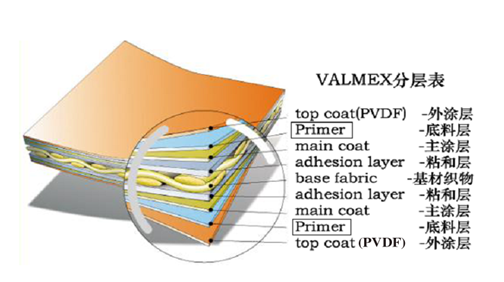
Acrylic/mixed PVDF/second generation PVDF
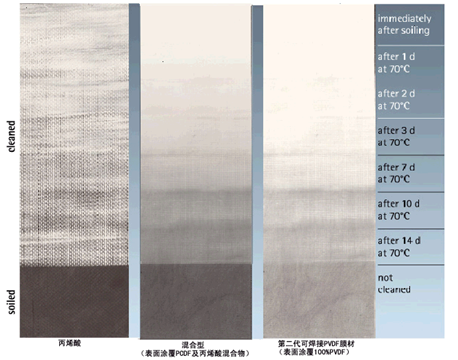
Fig. 2: Contrast diagrams of ultraviolet resistance of three coatings: Acrylic/mixed PVDF/second generation PVDF
Main Characteristics of the Second Generation PVDF Films
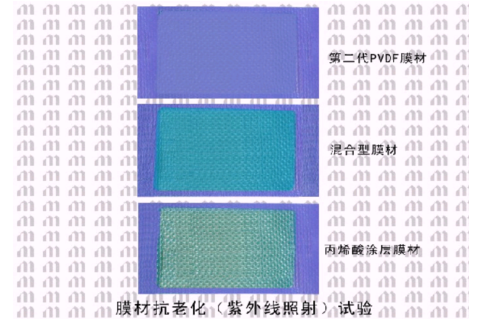
Direct welding
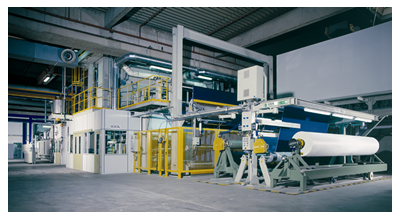
1)Direct welding is one of the important characteristics of the second generation PVDF film. In the manufacturing process of finished film, if it can not be welded directly, the back sticker or grinding method can only be used, which causes the following problems:
"Black groove" phenomenon: If the back-sticking method is used for welding, a "groove" with different width (gap) will be produced because of cutting error or the separation of the butt film after the stress is applied on the weld seam. Pollutants and rainwater will accumulate in addition, forming a black ditch, seriously affecting the overall beauty of the membrane structure. What is more serious is that after the accumulation of pollutants and rainwater, it penetrates into the membrane along the substrate fabric, resulting in mildew and peeling at the weld seam.
Insufficient weld strength: Because the design requirements of some membrane structures can not be welded by back sticking, the welding method of grinding the weld site of the membrane material can be adopted, which causes the hidden danger of unstable weld strength: deep grinding will destroy the overall structure of the membrane material, thereby reducing the strength; shallow grinding will result in the residual PVDF which can not be directly welded to weaken the weld strength. When the grinding width is wider, some of the membranes will lose the protection of PVDF coating and be exposed directly to the external environment. This part of the membranes will rapidly aging, deterioration and discoloration, and ultimately reduce the strength of the weld; when the grinding is narrower, some of the PVDF will be included in the weld, so that the actual weld width is less than the reasonable weld width, resulting in the decline of the weld strength.
Direct welding thoroughly eliminated the back sticking and grinding problems of the first generation PVDF film due to single-sided PVDF, and greatly reduced the workload of film processing.
The weldability of the second generation double-sided PVDF film mainly comes from the Primer coating. Primer coating is a unique high-tech invention.
2) Unique double-sided PVDF self-cleaning coating, double protection
The first generation PVDF films are mostly composed of 100% PVDF coating on the top and ACRYLIC coating on the bottom. The film lays particular emphasis on the protection of the top surface of the film, but lacks proper protection of the bottom surface of the film. So that various pollutants, water vapor, etc. will first erode the inner and outer layers with poor performance, making them aging, deteriorating or even falling off. This weakness is particularly prominent in membrane buildings such as ocean halls, swimming pools, gas stations and toll stations. Therefore, for membrane structure buildings with high requirements for both internal and external surface comprehensive performance, only one PVDF self-cleaning coating membrane material is not competent.
Double-sided PVDF film not only has a good protective effect on the top of the film, but also has a good protective effect on the bottom. It eliminates the engineering hidden danger caused by the ACRYLIC coating on the bottom of the first generation PVDF film, which can not protect the bottom of the film properly, and solves the problem of dust adsorption on the bottom of the film. At the same time, the self-cleaning, anti-aging and thermal insulation properties of the membrane material have been greatly improved.
3) Excellent anti-mildew and anti-seepage properties Selected the highest quality low yarn high density polyester filament (HT PES LOW WICK) in the world. This material has been greatly improved in anti-mildew, anti-capillary, anti-lateral seepage and other properties. At the same time, the adhesive layer contains excellent additives, which further strengthens the anti-mildew, anti-bacteria, anti-side seepage and other properties of the membrane. It completely eliminated the danger of mildew and falling off caused by side seepage of membrane material.
Excellent self-cleaning performance Because the outer coating of the membrane (PVDF coating) is added with high-efficiency modifier, it not only makes direct welding of the membrane possible, but also greatly improves its self-cleaning performance.
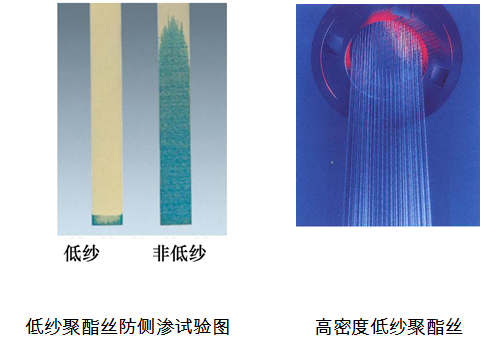
4) Excellent self-cleaning performance Because the outer coating of the membrane (PVDF coating) is added with high-efficiency modifier, it not only makes direct welding of the membrane possible, but also greatly improves its self-cleaning performance.
